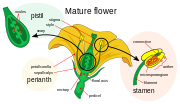Biseriate is a botanical term applied to both plantae and fungi, meaning 'arranged in two rows'. The term can refer to any number of structures found...
751 bytes (85 words) - 06:03, 3 November 2016
to as tepals). When the perianth is in two whorls, it is described as biseriate. While the calyx may be green, known as sepaloid, it may also be brightly...
6 KB (570 words) - 06:21, 26 August 2024
mosses. Andreaeopsida and Andreaeobryopsida are distinguished by the biseriate (two rows of cells) rhizoids, multiseriate (many rows of cells) protonema...
61 KB (6,983 words) - 16:07, 27 September 2024
members of Liliaceae the perianth is undifferentiated (perigonium) and biseriate (two whorled), formed from six free (i.e. apotepalous) caducous tepals...
67 KB (7,642 words) - 16:05, 27 September 2024
include the presence of both uniseriate (lined up in a single row) and biseriate (lined up in two rows) ascospores in the asci, pycnidia that are superficial...
2 KB (178 words) - 03:59, 21 September 2022
and colorless. Phialides are both uniseriate (arranged in one row) and biseriate. Recently, Petromyces was identified as the sexual reproductive stage...
24 KB (2,829 words) - 15:22, 22 July 2024
it does not have paraphyses, its asci are oblong, and its sporidia are biseriate and have an oblong-elliptical shape. Its perithecia mesaure to about 110–120 μm...
28 KB (2,267 words) - 07:29, 27 April 2024
The asci are narrowly elliptical, measuring 48–60 by 11–13 μm, with 8 biseriate to subbiseriate spores. The ascospores are narrowly elliptical, and 2-celled;...
2 KB (192 words) - 21:22, 4 July 2024
flowers are usually bisexual and usually epigynous. The perianth is usually biseriate, although the calyx is absent in some taxa (e.g. Theligonum). The calyx...
45 KB (4,220 words) - 11:45, 18 August 2024
protein-rich foods such as meats and cheeses. It is identified by its complex biseriate conidiophores on which phialides produce asexual spores. It can grow at...
4 KB (350 words) - 01:01, 11 January 2024
Susca A, et al. (August 2007). "Aspergillus brasiliensis sp. nov., a biseriate black Aspergillus species with world-wide distribution". International...
34 KB (3,583 words) - 01:34, 12 September 2024
mellein. It is a filamentous fungus in nature and has characteristic biseriate conidiophores. Traditionally a soil fungus, has now began to adapt to...
30 KB (3,544 words) - 22:33, 22 April 2024
with many layers of differentiated cells. This contrasts with the thin, biseriate (two cell-layer) integument of gnetophytes. Bennettitaleans also lack...
32 KB (3,294 words) - 19:49, 26 September 2024
worldwide. It is characterized by its yellow, thick-walled hyphae and biseriate sterigmata. The fungus produces citrinin and 5 unique depsipeptides, Aspergillicins...
27 KB (2,958 words) - 16:49, 29 June 2024
(ebracteate) be present. The perianth is undifferentiated (perigonium) and biseriate (two whorled), formed from six tepals arranged into two separate whorls...
112 KB (9,773 words) - 02:39, 27 August 2024
present, with a disc that is black and subpedicellate. Ascospores are biseriate and measure 12-21 × 5-9 μm. Dirinaria picta is distributed in various...
7 KB (667 words) - 21:25, 10 May 2024
hamathecium is not inspersed with oil droplets. The ascospores are irregularly biseriate, brown, and both distoseptate and muriform, with rounded lumina. No pycnidia...
3 KB (271 words) - 02:26, 24 July 2024
filaments, intercalary plurilocular reproductive structures uniseriate or biseriate and unilocular reproductive structures stalked and borne laterally at...
4 KB (447 words) - 14:01, 8 May 2022
and A. candidus var. densior. In 1877, Wilhelm described a species with biseriate sterigmata, globose vesicles, and short conidiophores as A. albus, which...
18 KB (2,012 words) - 03:01, 25 April 2024
Conidiophores terminate in small vesicles (10–15 μm in diameter) that are biseriate (i.e., with two successive layers of cells interposing the vesicle and...
16 KB (1,717 words) - 05:43, 19 April 2024
does not contain oil droplets. The ascospores are brown, irregularly biseriate (arranged in two rows), with mostly rounded to somewhat diamond-shaped...
4 KB (399 words) - 02:27, 24 July 2024
in uniseriate, they are directly on the conidial head, contrasted with biseriate where phialides rest on intermediate outgrowths of sterile cells called...
151 KB (13,044 words) - 14:10, 26 August 2024
per ascus, pale brown (dark brown only when postmature), irregularly biseriate, 3-septate, measuring 12–13.5 by 4.5–5.5 μm, with lumina becoming diamond-shaped...
3 KB (312 words) - 16:30, 22 December 2023
hyphal sheath, while the cyanobacterial filaments themselves are uni- or biseriate and have bluish-green cells that are often longitudinally divided. Dictyonema...
3 KB (320 words) - 21:32, 17 October 2023
bears seeds that are large and polygonal or irregularly flattened and biseriate. The seed testa is engraved into a puzzle like pattern. The globose bulbs...
25 KB (2,505 words) - 21:03, 18 May 2024
filaments, intercalary plurilocular reproductive structures uniseriate or biseriate and unilocular reproductive structures stalked and borne laterally at...
3 KB (296 words) - 23:08, 14 January 2023
other media. Aspergillus terreus has conidial heads that are compact, biseriate, and densely columnar, reaching 500 × 30–50 μm in diameter. Conidiophores...
28 KB (3,074 words) - 00:09, 11 January 2024
occurs in polar areas of both the Northern and Southern Hemispheres. biseriate Lined up in two parallel rows. bitunicate Also defined: endotunica, ectotunica...
221 KB (19,674 words) - 15:06, 6 September 2024
partially erumpent and up to 1 mm diameter. The sexual spores are eight biseriate ascospores occur inside of asci occur in immersed, partially erumpent...
6 KB (788 words) - 14:50, 19 January 2024
thick and contains asci and paraphyses. The ascospores are irregularly biseriate, measuring 6.0–8.5 by 2.5–3 μm. Pycnidia were not found in this lichen...
3 KB (327 words) - 14:04, 12 August 2023
















